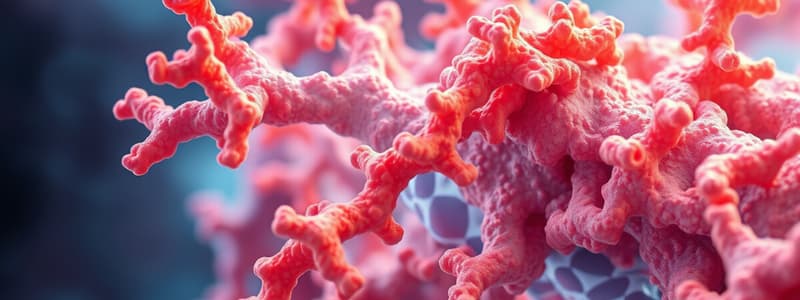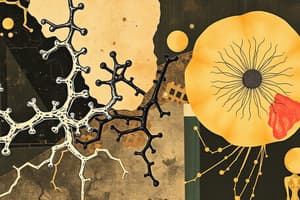Podcast
Questions and Answers
Which type of collagen is primarily found in cartilage and provides support to joint structures?
Which type of collagen is primarily found in cartilage and provides support to joint structures?
Which stage of collagen synthesis involves the formation of a triple helix?
Which stage of collagen synthesis involves the formation of a triple helix?
What is the main role of collagen in tissue repair?
What is the main role of collagen in tissue repair?
Which type of collagen is involved in cell adhesion and is located in connective tissues?
Which type of collagen is involved in cell adhesion and is located in connective tissues?
Signup and view all the answers
Which function of collagen contributes to the elasticity and resilience of tissues?
Which function of collagen contributes to the elasticity and resilience of tissues?
Signup and view all the answers
Study Notes
Types of Collagen
-
Type I:
- Most abundant in the body
- Found in skin, tendons, bones, and ligaments
-
Type II:
- Primarily found in cartilage
- Provides support and strength to joint structures
-
Type III:
- Common in skin, blood vessels, and internal organs
- Often found alongside Type I collagen
-
Type IV:
- Forms a network in basal lamina (part of the basement membrane)
- Provides structural support in tissues
-
Type V:
- Found in hair, placenta, and cell surfaces
- Regulates the assembly of collagen fibers
-
Type VI:
- Located in connective tissues
- Plays a role in cell adhesion and tissue structure
Collagen Synthesis
-
Stages of Synthesis:
-
Transcription:
- DNA is transcribed to mRNA.
-
Translation:
- mRNA is translated into pre-procollagen in the rough endoplasmic reticulum.
-
Post-translational Modifications:
- Hydroxylation of proline and lysine residues occurs (requires vitamin C).
- Glycosylation of hydroxylysine residues.
-
Triple Helix Formation:
- Pre-procollagen molecules assemble into a triple helix.
-
Secretion:
- Procollagen is secreted into the extracellular space.
-
Cleavage:
- Propeptides are cleaved to form mature collagen.
-
Assembly:
- Collagen fibrils are formed and aggregate into fibers.
-
Transcription:
Collagen Functions
-
Structural Support:
- Provides tensile strength to various tissues (skin, bones, cartilage).
-
Cell Adhesion:
- Facilitates attachment of cells to the extracellular matrix.
-
Tissue Repair:
- Plays a critical role in wound healing and tissue regeneration.
-
Mechanical Properties:
- Contributes to elasticity and resilience in tissues.
-
Biological Roles:
- Involved in signaling pathways and modulation of cellular functions.
-
Protection:
- Acts as a barrier in the extracellular matrix to protect cells and tissues.
Types of Collagen
-
Type I:
- Most prevalent collagen type, essential for skin, tendons, bones, and ligaments.
-
Type II:
- Major component of cartilage, crucial for providing strength and support to joint structures.
-
Type III:
- Found in skin, blood vessels, and internal organs; often coexists with Type I collagen.
-
Type IV:
- Generates a network structure in the basal lamina contributing to the basement membrane’s integrity.
-
Type V:
- Present in hair, placenta, and cellular surfaces; plays a key role in collagen fiber assembly regulation.
-
Type VI:
- Located within connective tissues, important for cell adhesion and maintaining tissue structure.
Collagen Synthesis
-
Process Overview:
- Transcription: Conversion of DNA into mRNA.
- Translation: mRNA transforms into pre-procollagen within rough endoplasmic reticulum.
-
Post-Translational Modifications:
- Hydroxylation of proline and lysine needing vitamin C; glycosylation of hydroxylysine occurs.
- Triple Helix Formation: Pre-procollagen molecules combine to form a stable triple helix structure.
- Secretion: Procollagen released into the extracellular space.
- Cleavage: Removal of propeptides resulting in the formation of functional mature collagen.
- Assembly: Collagen fibrils aggregate to form robust collagen fibers.
Collagen Functions
-
Structural Support:
- Provides tensile strength, vital for the stability and resilience of skin, bones, and cartilage.
-
Cell Adhesion:
- Essential for facilitating the attachment of cells to the extracellular matrix, aiding in tissue integrity.
-
Tissue Repair:
- Integral in wound healing and the regeneration processes of damaged tissues.
-
Mechanical Properties:
- Enhances tissue elasticity and resilience, allowing for flexibility and adaptation to stress.
-
Biological Roles:
- Involved in cellular signaling pathways, influencing various cellular functions.
-
Protection:
- Serves as a barrier in the extracellular matrix, safeguarding cells and tissues from injury.
Studying That Suits You
Use AI to generate personalized quizzes and flashcards to suit your learning preferences.
Description
Explore the various types of collagen and their unique roles in the body, from connective tissues to structural support. This quiz also covers the stages of collagen synthesis, including transcription and translation processes. Test your knowledge on the essential components of collagen and its biological significance.




